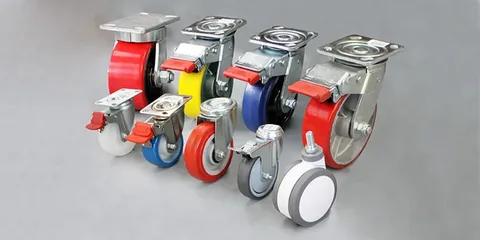When it comes to choosing the right type of castor wheels for your equipment, carts, or industrial machinery, the decision between swivel and rigid castor wheel can significantly impact functionality and efficiency. Understanding the differences between these two types will help you make the best choice for your specific application. In this article, we’ll be comparing swivel vs. rigid castor wheels: which one do you need?
What Are Castor Wheels?
Castor wheels are small, heavy-duty wheels mounted to the bottom of equipment, allowing for easier movement and transportation. They are widely used in various industries including manufacturing, retail, healthcare, and warehousing. Castor wheels come in two main types: swivel and rigid.
Swivel Castor Wheels: Maximum Maneuverability
Swivel castor wheels can rotate 360 degrees, allowing for smooth and flexible movement in any direction. These are especially useful in tight spaces or areas where frequent turning is required.
Advantages:
- Full directional movement
- Ideal for small or crowded spaces
- Enhances agility and flexibility
Common Uses:
- Hospital beds
- Office chairs
- Food service carts
If your priority is ease of turning and navigation around obstacles, swivel castors are likely the better option.
Rigid Castor Wheels: Stability and Straight Movement
Rigid castor wheels, also known as fixed castors, do not rotate. They only allow for forward and backward movement, which provides more control and stability, especially when transporting heavy loads in a straight line.
Advantages:
- Greater load-bearing capacity
- More stability in straight-line motion
- Less maintenance due to fewer moving parts
Common Uses:
- Industrial carts
- Warehouse equipment
- Heavy machinery platforms
Rigid castors are best suited for environments where equipment doesn’t need to turn frequently.
Comparing Swivel vs. Rigid Castor Wheels: Which One Do You Need?
When comparing swivel vs. rigid castor wheels, the right choice largely depends on the environment and purpose. Here are a few considerations:
- Mobility vs. Stability: If you need easy movement in all directions, go for swivel castors. For stability in straight-line movement, rigid castors are more appropriate.
- Load Requirements: Rigid castors often handle heavier loads better due to their fixed design.
- Space Constraints: Tight, confined spaces benefit from the maneuverability of swivel wheels.
- Combination Use: In many cases, a combination of both is ideal — swivel castors in the front and rigid ones in the back.
Conclusion
In summary, choosing between swivel and rigid castor wheels depends on your specific application and environment. By carefully comparing swivel vs. rigid castor wheels: which one do you need? — you can select the most effective option for your operational needs. Whether you prioritize maneuverability, stability, or load capacity, understanding the benefits of each type ensures better performance and efficiency in your workspace.

